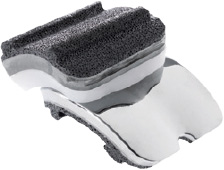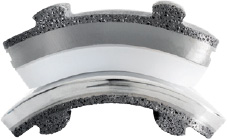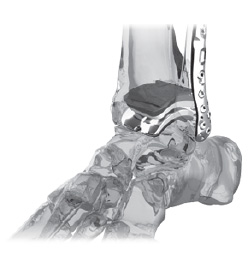
For decades, Zimmer has led the way with joint replacement innovations. Many of those advancements are reflected in the Zimmer Trabecular Metal Total Ankle replacement implant.
- The implant has a low-profile design that allows your surgeon to retain more of your natural bone than with many other implants. This is called bone sparing.
- Components of the implant work together to restore the natural movement of the ankle joint. This provides for integrated movement with muscles and tendons to help achieve a normal walking gait.1
- The Zimmer Trabecular Metal Total Ankle replacement system offers a number of sizing options, giving your surgeon the ability to choose the closest fit for your ankle anatomy.
Prolong® Highly Crosslinked Polyethylene
In ankle replacement surgery, the “bearing” material is the polyethylene surface that the metal components of the implant move against. Zimmer has developed a unique material that has shown to be resistant to wear.1 This material, Prolong Highly Crosslinked Polyethylene, has been used for many years in other joint implants and is intended to provide durability in the replacement ankle joint.2
Trabecular Metal Technology
This implant material is not a coating but rather an advanced 3-dimensional structure that closely resembles the porous structure of natural cancellous (“spongy”) bone.3
Advantages of a Lateral Approach

The Zimmer Trabecular Metal Total Ankle replacement system has been developed to give your surgeon an option for restoring natural movement to the ankle joint. Unlike other ankle replacement surgeries which use an incision on the front of the ankle, this procedure uses an incision on the side of the ankle, which is why it is called a lateral (side) approach. In this approach, the lower portion of the fibula is surgically moved to the side to perform the procedure and is later repositioned with a metal plate.

The lateral approach offers a number of benefits, including:
- Less disruption of nerves and soft tissues surrounding the ankle joint, which may speed up recovery and help restore a natural walking gait.
- The “side” view of your ankle joint during surgery allows your surgeon to see the joint better and is intended to help position the ankle replacement implant more precisely.
- If you’ve already had surgery on your ankle from a previous injury, the surgeon may be able to use the existing incision on the side of your ankle instead of having to create a new one.1
